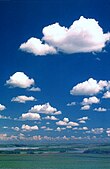Fluctus
fluctus (flu) (łac. falisty)[1] – krótkotrwałe zjawisko polegające na tworzeniu się struktur w kształcie załamujących się fal, występujące głównie na górnej powierzchni chmury.
Fenomen ten zachodzi pod wpływem niestabilności Kelvina-Helmholtza. Powstawanie tego zjawiska jest uwarunkowane występowaniem dwóch warstw powietrza, cieplejszej i chłodniejszej[2]. Warstwy poruszają się względem siebie, co w rezultacie powoduje tworzenie się charakterystycznych zawirowań[3].
Zazwyczaj można je zaobserwować w wietrzne dni, szczególnie nad obszarami górzystymi.
Fluctus towarzyszy takim chmurom, jak[4]:
Chmura ta jest również nazywana chmurą Kelvina-Helmholtza[5].
Przypisy
- ↑ D. Matuszko, J. Soroka, Nowa klasyfikacja chmur, „Przegląd Geofizyczny”, Z. 1-2, 2017, ISSN 0033-2135 [dostęp 2020-01-11] (pol.).
- ↑ Chmury Kelvina-Helmholtza | Fiztaszki, www.fiztaszki.pl [dostęp 2020-01-11].
- ↑ Karol Karwacki, Chmury Kelvina-Helmholtza, MeteoSerwis24.pl, 31 maja 2015 [dostęp 2020-01-11] (pol.).
- ↑ Learn About Kelvin-Helmholtz Clouds: Fluctus Cloud Feature, whatsthiscloud [dostęp 2020-01-11] (ang.).
- ↑ Fluctus | International Cloud Atlas, cloudatlas.wmo.int [dostęp 2020-01-13] (ang.).
Bibliografia
- https://cloudatlas.wmo.int/clouds-supplementary-features-fluctus.html
- https://whatsthiscloud.com/cloud-features/fluctus/
- https://weather.com/news/weather/news/2019-06-20-kelvin-helmholtz-wave-clouds-virginia
- http://yadda.icm.edu.pl/yadda/element/bwmeta1.element.baztech-0bfd6a82-eeff-4633-ae35-f5e52197ed78
- https://meteoserwis24.pl/chmury-kelvina-helmholtza/
- http://www.fiztaszki.pl/chmury-kelvina-helmholtza
Media użyte na tej stronie
Autor: Dwindrim (dyskusja · edycje), Licencja: CC BY-SA 1.0
This sky has "nice day" written all over it. The cumulus humilis indicates very little convection in the lower atmosphere, and the fact that it is well-formed indicates light winds at low levels. There is no cloud aloft, and thus no moisture or stable conditions or both. The cumulus congestus on the horizon suggests showers may be possible three or four hours from now, at the earliest, but chances are good it will remain a pleasant day through until the evening. The azure blue is typical of Alberta's clear, dust/haze/pollution-free skies.
Autor: Brocken Inaglory, Licencja: CC BY-SA 4.0
Kelvin Helmholtz instability clouds in San Francisco.These clouds, sometimes called "billow clouds," are produced by instability, when horizontal layers of air brush by one another at different velocities. A better name might be van Gogh clouds: It is widely believed that these waves in the sky inspired the swirls in van Gogh's masterpiece Starry Night
Autor: Rick Duffy, Licencja: CC BY-SA 4.0
Clouds exhibiting Kelvin-Helmholtz instability, seen over the foothills near Denver, Colorado, USA, January 25, 2015.





